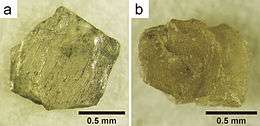Nanodiamond




Nanodiamonds are diamonds with a size below 1 micrometre. They can be produced by impact events such as an explosion or meteoritic impacts.
A single imperfection can give a nanodiamond an isolated color center, which lets it function as single, trapped atom. Relative to the defect size, they have huge surface areas that allow them to bond with a variety of other materials. Their non-toxicity means that nanodiamonds may be useful in biomedical and mechanical applications.[2][3]
History
In 1963, Soviet scientists at the All-Union Research Institute of Technical Physics noticed that nanodiamonds were created by nuclear explosions that used carbon-based trigger explosives.[2]
In 2015 Amanda S. Barnard, Science Leader of Australia’s Office of the Chief Executive (OCE), The Commonwealth Scientific and Industrial Research Organisation (CSIRO), received the Theory Prize at the Foresight Institutes' Feynman Awards. Using theoretical and computational methods, Dr. Barnard increased understanding of the structure and stability of carbon nanostructures and the role that shape plays in establishing properties and interactions under different conditions. The Prize announced focused on Dr. Barnard's work on diamond nanoparticles (nanodiamonds).[4]
Potential applications
The N-V center defect consists of a nitrogen atom in place of a carbon atom next to a vacancy (empty space instead of an atom) within the diamond’s lattice structure.[5]
Applying a microwave pulse to such a defect switches the direction of its electron spin. Applying a series of such pulses (Walsh decoupling sequences) causes them to act as filters. Varying the number of pulses in a series switched the spin direction a different number of times.[5] They efficiently extract spectral coefficients while suppressing decoherence, thus improving sensitivity.[6] Signal-processing techniques were used to reconstruct the entire magnetic field.[5]
The prototype used a 3 mm-diameter square diamond, but the technique can scale down to tens of nanometers.[5]
Micro-abrasive
Nanodiamonds share the hardness and chemical stability of visible-scale diamonds, making them candidates for applications such as polishes and engine oil additives for improved lubrication.[2]
Medical
Drug delivery
Diamond nanoparticles of ~5 nm in size offer a large accessible surface and tailorable surface chemistry. They have unique optical, mechanical and thermal properties and are non-toxic. The potential of nanodiamond in drug delivery has been demonstrated, fundamental mechanisms, thermodynamics and kinetics of drug adsorption on nanodiamond are poorly understood. Important factors include purity, surface chemistry, dispersion quality, temperature and ionic composition.
Nanodiamonds (with attached molecules) are able to penetrate the blood-brain barrier that isolates the brain from most insults. In 2013 doxorubicin molecules (a popular cancer-killing drug) were bonded to nanodiamond surfaces, creating the drug ND-DOX. Tests showed that tumors were unable to eject the compound, increasing the drug's ability to impact the tumor and reducing side-effects.[2]
Skin care
Nanodiamonds are well-absorbed by human skin. They also absorb more of the ingredients in skin care products than skin itself. Thus they cause more of the ingredients to penetrate the deeper layers of the skin. Nanodiamonds also form strong bonds with water, helping to hydrate the skin.[2]
Surgery
During jaw and tooth repair operations, doctors normally use invasive surgery to stick a sponge containing bone-growth-stimulating proteins near the affected area. However, nanodiamonds bind to both bone morphogenetic protein and fibroblast growth factor, both of which encourage bone and cartilage to rebuild and can be delivered orally.[2]
Blood testing
Defected nanodiamonds can measure the orientation of electron spins in external fields and thus measure their strength. They can electrostatically absorb ferritin proteins on the diamond surface where their numbers can be measured directly as well as the number of iron atoms (as many as 4,500) that make up the protein.[2]
Electronics
Sensor
Naturally occurring defects in nanodiamonds called nitrogen-vacancy (N-V) centers, have been used to measure changes over time in weak magnetic fields, much like a compass does with earth's magnetic field. The sensors can be used at room temperature, and since they consist entirely of carbon, they could be injected into living cells without causing them any harm, Cappellaro says.[5]
Optical computing
Nanodiamonds offer an alternative to photonic metamaterials for optical computing. The same single-defect nanodiamonds that can be used to sense magnetic fields can also use combinations of green and infrared light to enable/disrupt light transmission, allowing the construction of transistors and other logic elements.[2]
Quantum computing
Nanodiamonds with NV centers may serve as a solid-state alternative to trapped ions for room-temperature quantum computing.[2]
See also
- Aggregated diamond nanorod, a nanocrystalline form of diamond also known as nanodiamond or hyperdiamond
- Detonation nanodiamond
References
| Wikimedia Commons has media related to Nanodiamonds. |
- 1 2 3 Ohfuji, Hiroaki; Irifune, Tetsuo; Litasov, Konstantin D.; Yamashita, Tomoharu; Isobe, Futoshi; Afanasiev, Valentin P.; Pokhilenko, Nikolai P. (2015). "Natural occurrence of pure nano-polycrystalline diamond from impact crater". Scientific Reports. 5: 14702. PMC 4589680
 . PMID 26424384. doi:10.1038/srep14702.
. PMID 26424384. doi:10.1038/srep14702. - 1 2 3 4 5 6 7 8 9 Feinberg, Ashley (April 9, 2014). "How These Microscopic Diamonds Are Going to Shape the Future". Gizmodo. Retrieved April 2015. Check date values in:
|access-date=(help) - ↑ Mochalin, Vadym N., et al. "The properties and applications of nanodiamonds." Nature nanotechnology 7.1 (2012): 11-23.
- ↑ "2014 Foresight Institute Feynman Prize". Foresight Institute. April 2015. Retrieved April 2015. Check date values in:
|access-date=(help) - 1 2 3 4 5 "Using nanodiamonds to precisely detect neural signals". KurzweilAI. January 27, 2014. Retrieved April 2015. Check date values in:
|access-date=(help) - ↑ Cooper, A.; Magesan, E.; Yum, H. N. and Cappellaro, P. (2014). "Time-resolved magnetic sensing with electronic spins in diamond". Nature Communications. 5: 3141. PMID 24457937. doi:10.1038/ncomms4141.